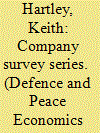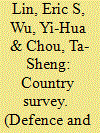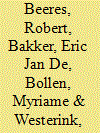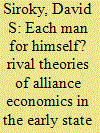|
|
|
Sort Order |
|
|
|
Items / Page
|
|
|
|
|
|
|
| Srl | Item |
| 1 |
ID:
113328


|
|
|
|
|
| Publication |
2012.
|
| Summary/Abstract |
BAE Systems is the UK's largest defence and security firm and one of the world's major arms companies. It has changed from a state-owned aerospace firm to a privatised specialist defence company involved in a range of air, land, sea and cyber systems with a major presence in the US defence market. This article describes and assesses the history of the company, its organization, conduct and performance.
|
|
|
|
|
|
|
|
|
|
|
|
|
|
|
|
| 2 |
ID:
113329


|
|
|
|
|
| Publication |
2012.
|
| Summary/Abstract |
In this article we survey military spending, the evolution of national defense policy, and the role that defense spending played in economic activities in Taiwan from 1952 to 2009. With the ongoing cross-Strait dialogue and closer commercial ties between Taiwan and China, the share of military spending in government expenditures (or GDP) has tended to gradually decline, which is in accordance with the change in defense policy from an offensive posture to a defensive-oriented attitude. In addition, we investigate the defense spending-inflation nexus in Taiwan. The multivariate structural change test identifies two break points and three regimes are categorized accordingly. The Granger causality test based on the VAR model reveals that the heavy defense burden in Taiwan during 1952-71 (the first regime) is essentially an important factor causing the higher price levels. However, when the tension across the Taiwan Strait is alleviated as well as the defense-oriented policy adopted, the military spending no longer plays a crucial role in determining inflation in the recent two regimes. Sensitivity analysis confirms that our results are robust to different model specifications.
|
|
|
|
|
|
|
|
|
|
|
|
|
|
|
|
| 3 |
ID:
113330


|
|
|
|
|
| Publication |
2012.
|
| Summary/Abstract |
This article examines the pattern of expenditures for national security of the Netherlands from 1990 until 2009. In 1990, military spending amounted to 2.7% of Gross Domestic Product (GDP). In 2009, almost two decades later, this ratio dropped by more than a full percent. During this period, the reduction of funds available for national security was in concurrence with the Dutch government's spending policies. The Netherlands Armed Forces (NAF) changed dramatically in terms of capabilities, size, equipment and personnel in this two-decade time span. Our investigative results indicate that in spite of this transition, no significant changes have been implemented since 1990 in how the Dutch defence budget is allocated for the Navy, Army and Air Force. Furthermore, the mix of expenditures for salaries, operations and maintenance, as well as those for capital investment, stayed roughly the same for the duration of the period studied.
|
|
|
|
|
|
|
|
|
|
|
|
|
|
|
|
| 4 |
ID:
113327


|
|
|
|
|
| Publication |
2012.
|
| Summary/Abstract |
When military alliances are expensive, they naturally raise distributional issues. This article considers two theories to explain how much a state will voluntarily contribute to the economic burdens of defense. Empirical work has relied largely on data from the twentieth century. This article provides an out-of-sample test to evaluate the models. Using data on the Quintuple Alliance, the results are more consistent with the predictions of the joint products model than the pure public goods model. Due to credible commitment problems, and intra-alliance cleavages, I argue that we should not expect substantial free riding in most conventional military alliances.
|
|
|
|
|
|
|
|
|
|
|
|
|
|
|
|
| 5 |
ID:
113331


|
|
|
|
|
| Publication |
2012.
|
| Summary/Abstract |
Testing the existence of budgetary trade-offs in eighteenth-century Britain and Spain can contribute to resolve the debate on the economic impact of warfare and its relationships with the military potential of nations and the struggle for world supremacy during the early modern period. We have constructed several empirical models to search for trade-offs in order to show which country had the whip hand in achieving its military and economic objectives. Britain was ahead of Spain for several reasons. Britain was more efficient in deploying the available resources because it built an effective national bureaucracy. Furthermore, the institutional reforms made from the seventeenth century onwards increased the level of resources through enhancement of the British economy.
|
|
|
|
|
|
|
|
|
|
|
|
|
|
|
|
|
|
|
|
|